For our discovery tour in Bangkok we decide to test the express boat as an alternative to the Skytrain and the Metro. From the Skytrain station, it is only about 300 m in northern direction to the Elephant bridge. At the Saphan Hua Chang Pier is the jetty of the express boat.
Saphan Hua Chang Pier
At boarding, the boat one should be a little agile. The boat drives at an astonishing high speed through the Khlong. The air stream is a welcome refreshment in Bangkok at the high temperatures. But you should pull up the plastic foil attached to the to the sides, to protect yourself from splashing water.

The journey with the express boat offers interesting insights into the living environment of the residents of Bangkok. Our destination is the intersection of Ratchadamnoen Boulevard and Thanon Mahachak.
King Prajadhipok Museum
First, we have a look at the King Prajadhipok Museum. Visitors will get a good insight into the life of the Royal Family.
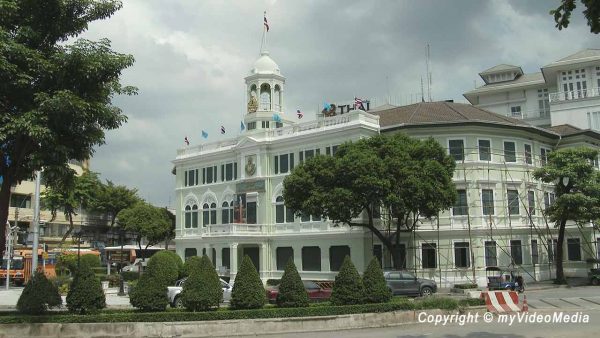
You see items of daily life, especially from the 1920s and 1930s, such as clothes and furniture. Admission is free.
Wat Ratchanatdaram
We decide to make a short visit at the Wat Ratchanatdaram with the Loha Prasat temple. The architecture of the temple is unusual in Bangkok. After studying Sri Lanka Buddhism, King Nangklao (Rama III) had the temple built in 1846. It is reminiscent of a temple built in Anuradhapura, in 150 BC. The former nine-storied building had a side length of 120 m. 1600 stone columns formed the still preserved foundation.
Please watch the 4K UHD video below
You are currently viewing a placeholder content from YouTube. To access the actual content, click the button below. Please note that doing so will share data with third-party providers.
More InformationThe Loha Prasat is considerably smaller, it has only 3 stories and is 36 m high. The top carries a Burmese umbrella (Hti). Rama III had Wat Ratchanatda built in 1846 for his niece Mom Chao Ying Sommanad Wattanawadi, the later queen, and wife of King Mongkut (Rama IV), as a place for the undisturbed meditation build.
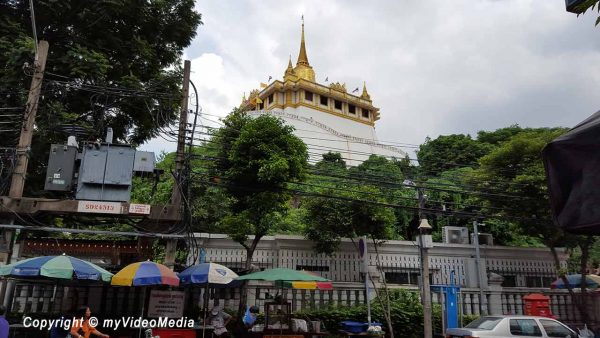
Afterward, we go to Wat Saket, the Golden Mountain. It is near, on the other side of a khlong. We do not want to climb up because the weather does not promise a good distant view.
Ratchadamnoen Avenue
The Ratchadamnoen Avenue is the middle part of the royal processional route that links the Grand Palace with the newer Dusit palace.
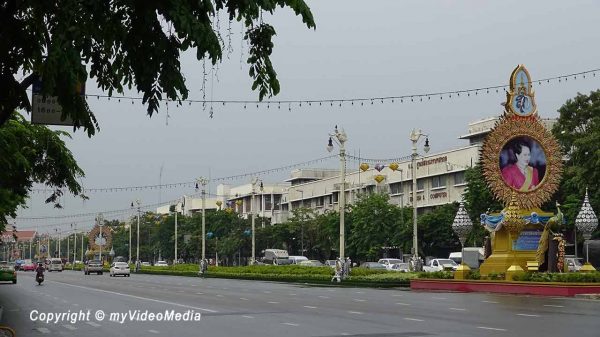
It is decorated with pictures of the royal family in golden frames. We go along up to the Democracy Monument.
Democracy Monument
The Democracy Monument is one of Bangkok’s landmarks. In the center is a hexagonal shrine, with two golden offering bowls. On top of them is a symbolic sculpture, representing the constitution of 1932. Around the shrine are 4 wing-like concrete pillars, grouped as symbolic protection. They symbolize the armed forces participating in the coup in 1932, that leads to the constitutional monarchy.
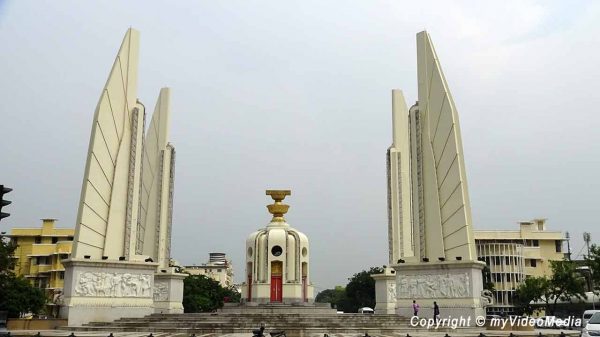
At the southeast corner of the square, we find a historical map of Ayutthaya in the 17-19th century. It was the golden age of the old capital city of Siam.
We turn south and reach the city hall.
City hall
On the opposite side is Wat Suthat, the largest temple in Bangkok. Between stands the Giant Swing Sao Ching Cha. King Phra Phutthayotfa Chulalok (Rama I) built the swing in 1784. It goes back to a court ceremony for the traditional celebration of the Brahman New Year. Four men on the swing tried to catch a purse which hung up on a pillar, standing opposite. The foremost man had to collect the purse with his teeth. The ceremony was abandoned in 1935 after serious accidents.

Between the swing and the city hall we see a monument, showing the official name of the city of Bangkok.

The full Thai name for Bangkok has more than hundred characters and is regarded as longest name of a city worldwide.
Bamrung Muang Road
As we move eastwards, we come to a shopping area, where the buyers better have a delivery van. In Bamang Muang Road, Buddhas and other religious statues for every purpose are sold. The life-size figures can only be transported in a delivery van.

North of it, we find a quarter which is still stuck in the colonial era. The one-storey houses and green squares convey authentic life during the colonial time.
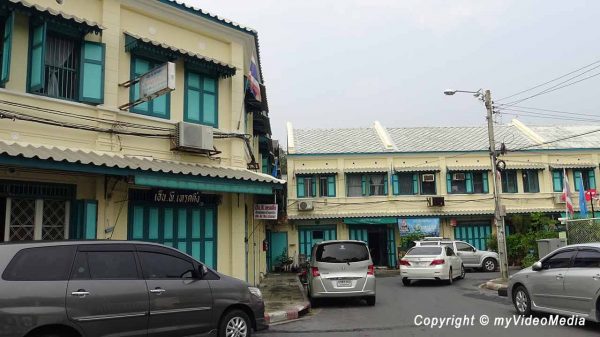
Where the road meets the Rop Krung Khlong, the colonial buildings house some military organizations, such as the Ministry of Defense and the Ministry of the Interior.
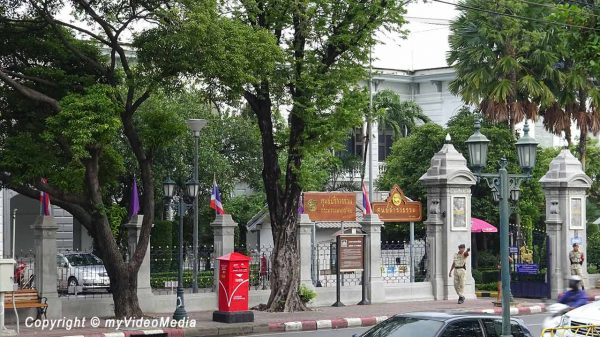
We walk along the canal to reach Rachini Alley and Chao Fa Road.
To the left is a monument showing Queen Patcharindra.According to a legend, she squeezes her hair so that people would have access to clean drinking water.
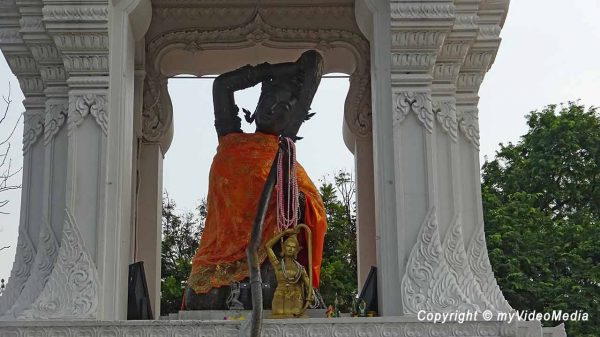
On the right, we see the Erawan statue. Erawan is a mythological elephant that usually has at least three, sometimes even 33 heads.
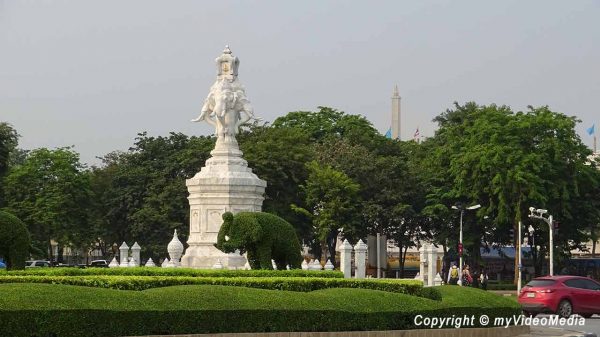
From here, it is only a few steps to Khao San Road and we go back to our hotel.
Please read on > Cloud 47 rooftop and 4 people in a tuk-tuk
Pin it for later
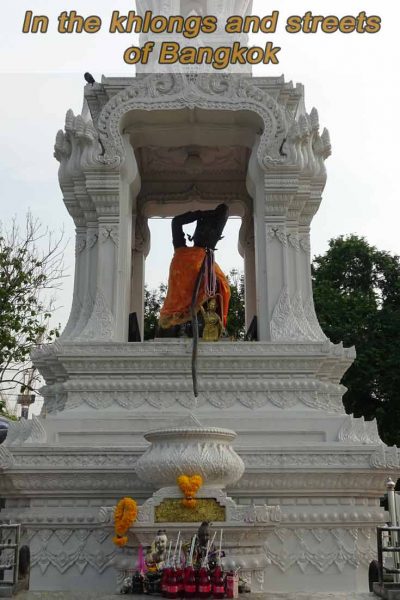
Text, photos and video: Copyright © myVideoMedia